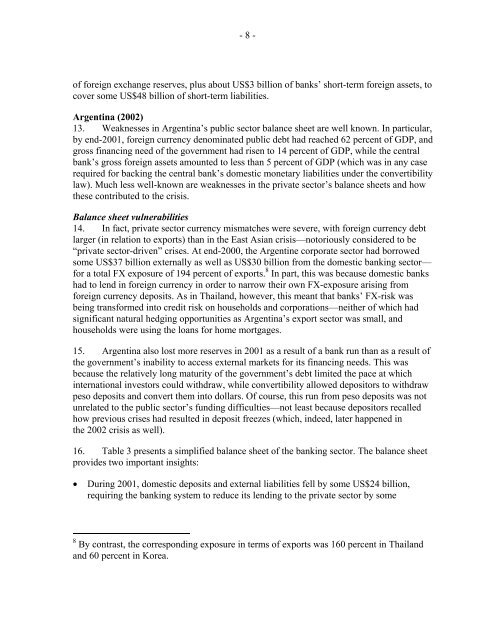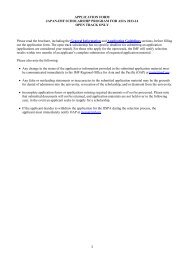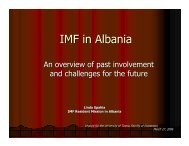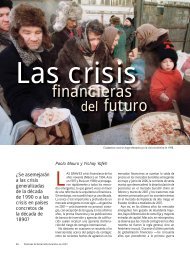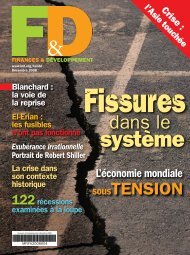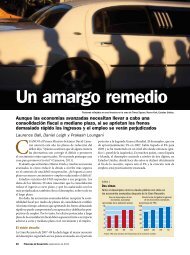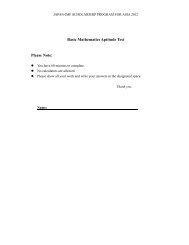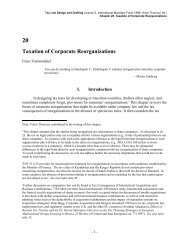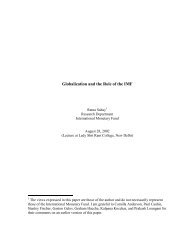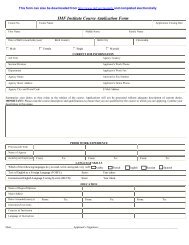Overview of Capital Account Crisis - IMF
Overview of Capital Account Crisis - IMF
Overview of Capital Account Crisis - IMF
You also want an ePaper? Increase the reach of your titles
YUMPU automatically turns print PDFs into web optimized ePapers that Google loves.
- 8 -<br />
<strong>of</strong> foreign exchange reserves, plus about US$3 billion <strong>of</strong> banks’ short-term foreign assets, to<br />
cover some US$48 billion <strong>of</strong> short-term liabilities.<br />
Argentina (2002)<br />
13. Weaknesses in Argentina’s public sector balance sheet are well known. In particular,<br />
by end-2001, foreign currency denominated public debt had reached 62 percent <strong>of</strong> GDP, and<br />
gross financing need <strong>of</strong> the government had risen to 14 percent <strong>of</strong> GDP, while the central<br />
bank’s gross foreign assets amounted to less than 5 percent <strong>of</strong> GDP (which was in any case<br />
required for backing the central bank’s domestic monetary liabilities under the convertibility<br />
law). Much less well-known are weaknesses in the private sector’s balance sheets and how<br />
these contributed to the crisis.<br />
Balance sheet vulnerabilities<br />
14. In fact, private sector currency mismatches were severe, with foreign currency debt<br />
larger (in relation to exports) than in the East Asian crisis—notoriously considered to be<br />
“private sector-driven” crises. At end-2000, the Argentine corporate sector had borrowed<br />
some US$37 billion externally as well as US$30 billion from the domestic banking sector—<br />
for a total FX exposure <strong>of</strong> 194 percent <strong>of</strong> exports. 8 In part, this was because domestic banks<br />
had to lend in foreign currency in order to narrow their own FX-exposure arising from<br />
foreign currency deposits. As in Thailand, however, this meant that banks’ FX-risk was<br />
being transformed into credit risk on households and corporations—neither <strong>of</strong> which had<br />
significant natural hedging opportunities as Argentina’s export sector was small, and<br />
households were using the loans for home mortgages.<br />
15. Argentina also lost more reserves in 2001 as a result <strong>of</strong> a bank run than as a result <strong>of</strong><br />
the government’s inability to access external markets for its financing needs. This was<br />
because the relatively long maturity <strong>of</strong> the government’s debt limited the pace at which<br />
international investors could withdraw, while convertibility allowed depositors to withdraw<br />
peso deposits and convert them into dollars. Of course, this run from peso deposits was not<br />
unrelated to the public sector’s funding difficulties—not least because depositors recalled<br />
how previous crises had resulted in deposit freezes (which, indeed, later happened in<br />
the 2002 crisis as well).<br />
16. Table 3 presents a simplified balance sheet <strong>of</strong> the banking sector. The balance sheet<br />
provides two important insights:<br />
• During 2001, domestic deposits and external liabilities fell by some US$24 billion,<br />
requiring the banking system to reduce its lending to the private sector by some<br />
8 By contrast, the corresponding exposure in terms <strong>of</strong> exports was 160 percent in Thailand<br />
and 60 percent in Korea.


